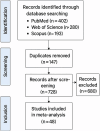Brucellosis in Marine Mammals: Meta-Analysis of Prevalence, Infection Patterns, Host Specificity and Zoonotic Potential
- PMID: 40788178
- PMCID: PMC12337757
- DOI: 10.1002/vms3.70557
Brucellosis in Marine Mammals: Meta-Analysis of Prevalence, Infection Patterns, Host Specificity and Zoonotic Potential
Abstract
Background: Marine brucellosis, primarily caused by Brucella species, presents significant ecological and public health challenges, impacting marine biodiversity and posing zoonotic risks. Despite ongoing research, data on the disease's prevalence, host specificity and transmission within marine ecosystems remains limited, underscoring the need for comprehensive analysis.
Objective: This review assesses Brucella infection patterns in marine mammals, focusing on prevalence, species susceptibility and implications for conservation and health strategies.
Methods: We conducted a systematic review and meta-analysis using PubMed, Web of Science and Scopus, covering studies from 2001 to 2024. Random-effects models were employed to analyse prevalence rates, transmission pathways and regional variations, accounting for high inter-study heterogeneity.
Results: The analysis revealed substantial variation in Brucella detection rates, ranging from 0.25% to 100%, with an average pooled prevalence of approximately 30%. Species-specific susceptibility was identified, with cetaceans showing the highest infection rates (52%), followed by other marine mammals (30%) and pinnipeds (18%). High prevalence rates were observed in species such as striped dolphins and beluga whales, particularly in the Mediterranean and Arctic regions. Geographic patterns indicated Asia as the region with the highest prevalence (36%), followed by Oceania and Antarctica, suggesting environmental and population density factors may influence infection rates. Smaller studies displayed a tendency toward higher reported detection rates, indicating potential publication bias.
Conclusion: This meta-analysis underscores the widespread prevalence of Brucella in marine mammals and the pressing need for advanced diagnostics, strengthened surveillance and targeted interventions, particularly in high-risk regions and species. An interdisciplinary, collaborative approach including the development of molecular diagnostic tools and international research partnerships will be essential to support conservation efforts and mitigate zoonotic risks associated with marine brucellosis.
Keywords: Brucella prevalence; marine brucellosis; marine mammal health; molecular diagnostics; zoonotic disease.
© 2025 The Author(s). Veterinary Medicine and Science published by John Wiley & Sons Ltd.
Conflict of interest statement
The authors declare no conflicts of interest.
Figures






Similar articles
-
The Global Seroprevalence of Equine Brucellosis: A Systematic Review and Meta-analysis Based on Publications From 1990 to 2022.J Equine Vet Sci. 2023 Apr;123:104227. doi: 10.1016/j.jevs.2023.104227. Epub 2023 Jan 14. J Equine Vet Sci. 2023. PMID: 36649828
-
Comprehensive Meta-Analysis of Brucellosis in Wild and Domestic Birds: Unraveling the Complex Interplay of Transmission and Ecology (1970-2024).Curr Microbiol. 2025 Jul 30;82(9):425. doi: 10.1007/s00284-025-04412-w. Curr Microbiol. 2025. PMID: 40739071
-
Beyond Serology: A Meta-Analysis of Advancements in Molecular Detection of Brucella spp. in Seronegative Animals and Biological Samples.Vet Med Sci. 2025 Jan;11(1):e70200. doi: 10.1002/vms3.70200. Vet Med Sci. 2025. PMID: 39792571 Free PMC article.
-
Systematic review of brucellosis in Kenya: disease frequency in humans and animals and risk factors for human infection.BMC Public Health. 2016 Aug 22;16(1):853. doi: 10.1186/s12889-016-3532-9. BMC Public Health. 2016. PMID: 27549329 Free PMC article.
-
Detection of Brucella ceti and Brucella-Associated Disease in Stranded Cetaceans in Hawaii, USA, 2000-24.J Wildl Dis. 2025 Apr 1;61(2):522-529. doi: 10.7589/JWD-D-24-00146. J Wildl Dis. 2025. PMID: 40170330
References
-
- Abe, E. , Ohishi K., Ishinazaka T., Fujii K., and Maruyama T.. 2017. “Serologic Evidence of Brucella Infection in Pinnipeds Along the Coast of Hokkaido, the Northernmost Main Island of Japan.” Microbiology and Immunology 61: 114–122. - PubMed
-
- Aguirre, A. A. , Keefe T. J., Reif J. S., et al. 2007. “Infectious Disease Monitoring of the Endangered Hawaiian Monk Seal.” Journal of Wildlife Diseases 43, no. 2: 229–241. - PubMed
-
- Attademo, F. L. N. , Silva J. C. R., Luna F. O., et al. 2018. “Retrospective Survey for Pathogens in Stranded Marine Mammals in Northeastern Brazil: Brucella spp. Infection in a Clymene Dolphin (Stenella clymene).” Journal of Wildlife Diseases 54, no. 1: 151–155. - PubMed
-
- Ávalos‐Téllez, R. , Ramírez‐Pfeiffer C., Hernández‐Castro R., et al. 2014. “Infection of California Sea Lions (Zalophus californianus) With Terrestrial Brucella spp.” Veterinary Microbiology 173: 118–124. - PubMed
-
- Bressem, M. , Raga J., Guardo G., et al. 2009. “Emerging Infectious Diseases in Cetaceans Worldwide and the Possible Role of Environmental Stressors.” Diseases of Aquatic Organisms 86, no. 2: 143–157. - PubMed
Publication types
MeSH terms
LinkOut - more resources
Full Text Sources
Medical

